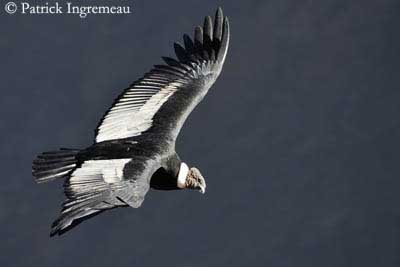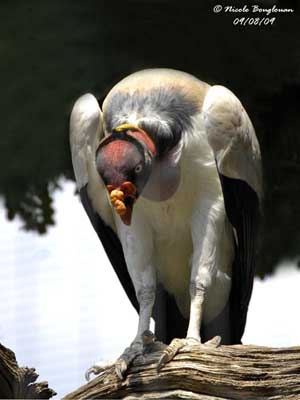
FAMILY CATHARTIDAE
New World Vultures – Vultures and Condors
The New World Vultures come and go from Ciconiiformes, through Falconiformes and Cathartiformes, and finally to Accipitriformes where their current place is.
These raptors differ in appearance from the Old World Vultures (Family Accipitridae) because they probably descend from different ancestry. However, they are adapted to a similar way of life, with same feeding, breeding, nesting and flying behaviours.
Both groups include raptors which are among the largest flying birds such as the condors Gymnogyps and Vultur in the Americas, and the griffon vultures of the genus Gyps in the Old World. They have rather dark plumage, pale neck ruff, bare face and strong bill.
But we can also find medium-sized to large birds in both groups, such as the King Vulture (Sarcoramphus papa) in the New World, and the White-headed Vulture (Trigonoceps occipitalis) and the Lappet-faced Vulture (Torgos tracheliotus) in the Old World. These raptors tend to have brighter plumage.
And finally, both groups have smaller birds such as the American Black Vulture (Coragyps atratus) and the Turkey Vulture (Cathartes aura) in the New World, and the Hooded Vulture (Necrosyrtes monachus) and the Egyptian Vulture (Neophron percnopterus) in the Old World. These smaller raptors have thinner and less powerful bills.
Text by Nicole Bouglouan
Photographers :
Didier Buysse
Vision d’Oiseaux
Alfredo Colón
Puerto Rico Wildlife
Dechelle Maxime
LEPAPARRAZO
Jean Michel Fenerole
Photos d’Oiseaux
Tom Grey
Tom Grey's Bird Pictures
Patrick Ingremeau
TAMANDUA
Eduardo Andrés Jordan
MIS AVES – AVES DE ARGENTINA
Tom Merigan
Tom Merigan’s Photo Galleries
Bob Moul
Nature Photography
Philippe et Aline Wolfer
GALERIE
Nicole Bouglouan
PHOTOGRAPHIC RAMBLE
Sources :
HANDBOOK OF THE BIRDS OF THE WORLD Vol 2 by Josep del Hoyo-Andrew Elliot-Jordi Sargatal - Lynx Edicions - ISBN: 8487334156
A GUIDE TO THE BIRDS OF MEXICO AND NORTHERN CENTRAL AMERICA by Steve N. G. Howell, Sophie Webb - Oxford University Press - ISBN: 0198540124
A GUIDE TO THE BIRDS OF COLOMBIA by Steven L. Hilty and William L. Brown - Princeton University Press – ISBN 069108372X
BIRDS OF THE GREAT BASIN – by Fred A. Ryser - Univ of Nevada Pr -ISBN: 0874170796
Wikipedia (Wikipedia, The Free Encyclopedia)
SORA Searchable Ornithological Research Archive (Blair O. Wolf)

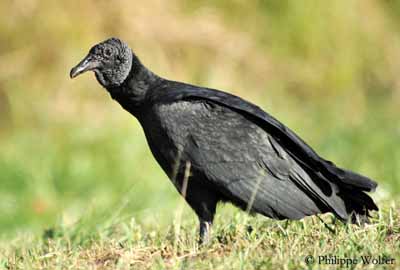
Outside the technical language of the DNA and the wandering of these birds from an order to a new one due to similarities between species, one fact is actually very interesting: fossils of Old World Vultures were found in the New World, in California, showing that they may have become extinct recently, about 10.000 years ago.
However, fossils of New World Vultures found in the Old World are much more ancient with about 20 millions years.
The Cathartids vultures have hooked bill with cutting edges, well adapted to their feeding behaviour. Head and neck are bare, an adaptation to keep their feathers clean after poking the head into carcasses.
This bare skin plays a role in temperature regulation when the birds land on the ground, after long periods spent at high elevation where the air is cold. They need a thick plumage to retain the heat when in flight, but on the ground, the bare areas help and keep them from overheating.
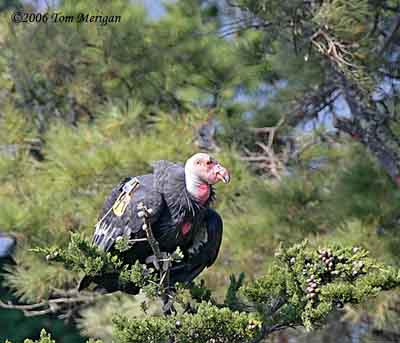
But these bare areas are also important during the displays, and show a spectacular and large range of colours such as in the King Vulture which has in addition skin folds and pendulous wattles.
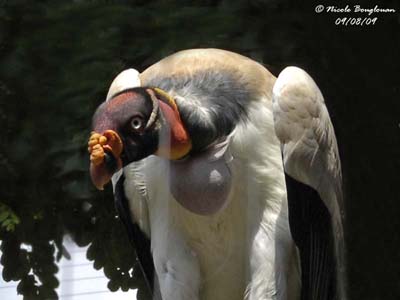
These colours occur only in adults. The immature birds have dark greyish or blackish skin. Colours vary according to each bird, and are used in individual recognition, threats or dominance behaviours between adults, and especially at feeding sites. The colour may change in a few seconds, by constricting or dilating the blood capillaries of these areas. This fact is particularly visible in the Turkey Vulture.
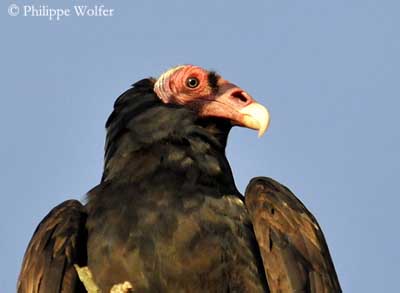
Air-sac systems are associated to the bare skin, and are particularly developed in the California Condor. They add something more to the displays when the skin blows up as a balloon and emphasizes the bright colours of the neck. The Andean Condor, the Turkey Vulture and the American Black Vulture also have this particularity, but less dramatic.
The members of the genus Cathartes have peculiar feature, the large nostrils on the bill sides. These largely open nostrils allow them to have a very good sense of smell, demonstrated in numerous studies. They can locate food in forests, and find carcasses among the vegetation or hidden from the view. However, they do not take putrefying meat, probably because it contains toxins due to the bacteria action.
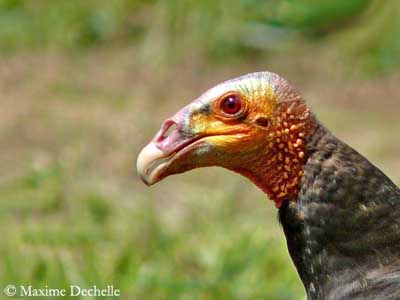
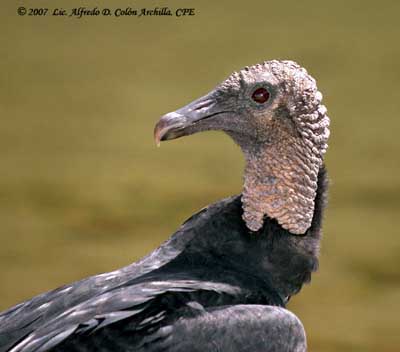
As only the three Cathartes species have this sense of smell, the King Vulture and the American Black Vulture follow them in forest habitat in order to find a carcass and then, they steal the food.
The New World vultures have generally blackish plumage sometimes with some iridescence of feathers on the upperparts, mainly blue-green. The Andean and the California Condors, and also the King Vulture show white patches on the wings, well visible in flight.
All have large wing areas, and are well adapted for soaring and gliding flight. They use the thermals currents for rising, without any flapping flight. Then, they glide while loosing altitude little by little, until they find a new rising current to gain altitude again. This method allows the raptors to travel long distances with little energy. The condors which are living in mountainous areas also use the rising currents on the cliff sides.
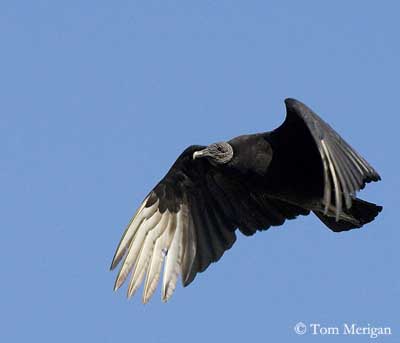
All these vultures have large feet. They use them when feeding to hold the food while the bill tears off pieces of flesh. Most species have slight webbing between the toes, used to slow the flying speed as they land. The large species have high flight speed and it is difficult for them to control their descent. For that, they lower the feet to slow their landing, as the Old World vultures do. They also have small webs between the toes.
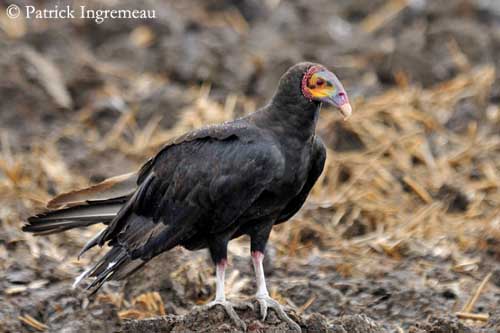
When searching for food, the Cathartes fly low from the ground, in order to find a smell, more present close to the ground. On the other hand, the other vultures fly higher and search by sight.
They are scavengers, feeding almost exclusively on dead animals, roadkills and carcasses from large and medium-sized to small mammals.
The Cathartes may find small carcasses thanks to their good sense of smell. The other vultures find larger carcasses by sight.
The American Black Vulture kills a wide range of food items but often defenceless. The Turkey Vulture may also kill preys, but only very sick or young animals.
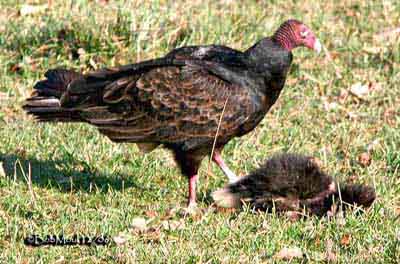
The hierarchy around a carcass is simple. The large condors are able to open up the skin with their powerful beak, and they start first. Then, the other raptors feed the muscles and viscera. The three Cathartes vultures feed more slowly and they clean up all the remaining bits of meat on the bones.
Fights between them are very rare, in spite of so many species around the same food. For them, physical contact might be dangerous and lead injury, because vultures have delicate wings. But also, fights waste energy. For this reason, several ritual displays have been evolved, allowing them to know where the dominant is. Usually, the larger species dominate over the smaller ones.
Some threat displays involve two birds stand side by side with open wings, and push against each other until one falls. Another displays show two birds rising into the air and kicking at each other with the feet. The American Black Vultures form large groups at food source and can make massed assaults, driving away the other species, even the King Vulture.
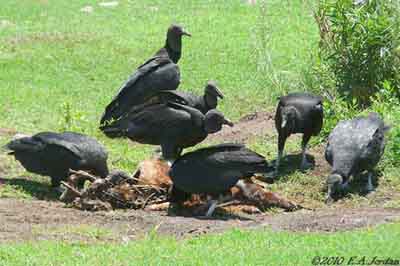
The two condors feed mainly on large carcasses. But their numbers are so reduced that today, it is usual to find only a few Andean Condors around the food whereas in the past, they were numerous feeding on the same dead animal as the Gyps vultures in Africa.
The California Condor forages along the pacific coasts where marine mammals are regularly washed up along the beach.
All these vultures play an important role in ecosystems as scavengers.
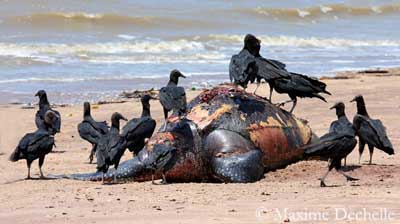
The Cathartids vultures are almost silent birds, because they lack the syrinx and the associated muscles. They are unable to produce any call or song, but however, they can produce several strange sounds such as hisses, rattles, snorts, sneezes, wheezes, none of them very loud. These sounds are probably the result of the air passing through the air-sacs, but they are not used very often.
These noises are usually heard around a carcass or during the breeding season.
The cathartids occupy a wide range of habitats.
The Andean Condor is found among the highest mountains of the Andes, but it descends to the low grasslands of Argentina, and occurs in desert in coastal Peru.
The California Condor is now confined to the Sierra Nevada in California, but formerly, it was found in most parts of southern North America.
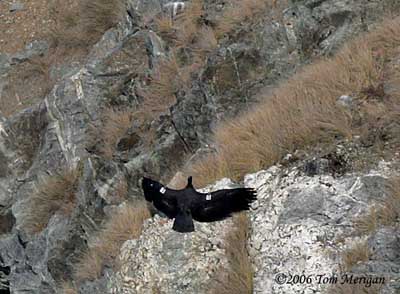
The King Vulture occurs in undisturbed areas of tropical forest in central and South America, although it may be found in grasslands and savannas.
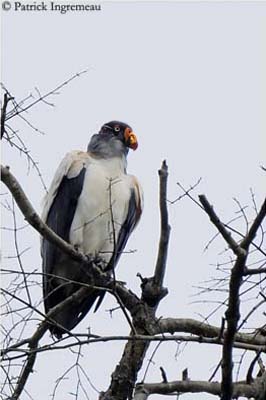
The American Black Vulture was formerly confined to the edges of streams, swamps and wetlands. Today, its range is more extended, and this vulture scavenges in towns and frequents rubbish dumps in the cities of Central and South America.
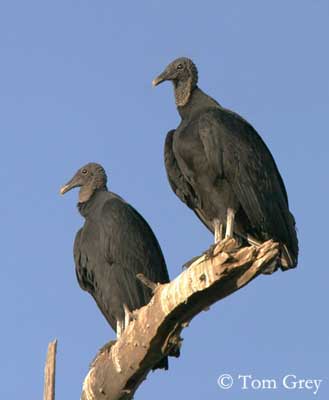
The Turkey Vulture may be found from extreme deserts to grassland, temperate forest and tropical rainforest. It is present from southern Canada to Cape Horn.
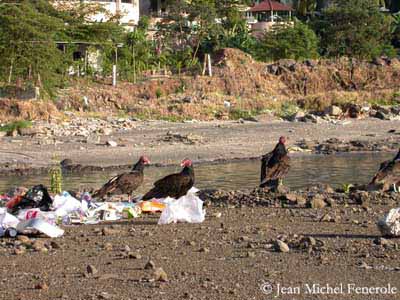
The Lesser Yellow-headed Vulture frequents grasslands, llanos, savannas and forest edges in Mexico, Central and South America.
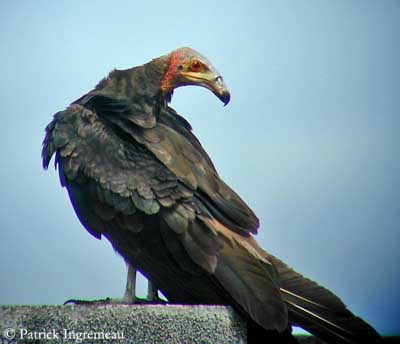
The Greater Yellow-headed Vulture prefers undisturbed lowland tropical forest in South America, mainly in Amazon Basin.
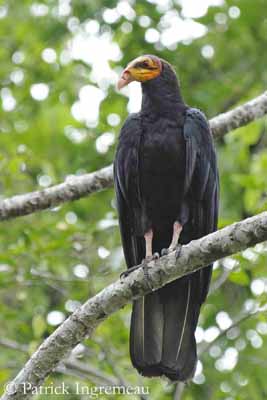
All the New World vultures show a stunning sunning behaviour, very important for their health and plumage. They are often seen perched on trees or poles with the wing fully extended and the body towards or away from the sun. This behaviour is necessary in the early morning, because their body temperature looses several degrees during the night, and they need the heat of the sun to recover it. In addition, the feathers often become bent after several hours soaring in cold air, and the feather’s tips can remain upwards. The heat of the sun allows the birds to recover the right shape for an efficient flight.
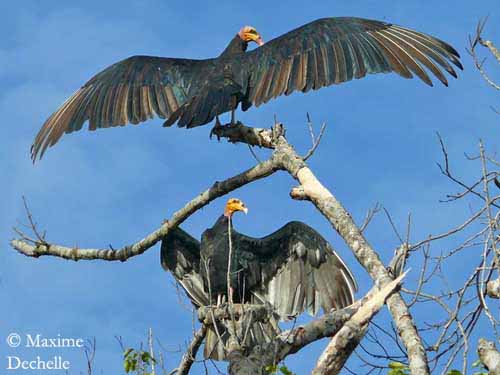
Little is known about the breeding and nesting behaviours of Cathartids vultures. The breeding season varies according to the range and is poorly know.
The American vultures are not as gregarious as the Old World vultures which often nest in colonies. The New World vultures tend to nest solitary, but the American Black Vulture may gather in large numbers for feeding and roosting and this is an important social behaviour.
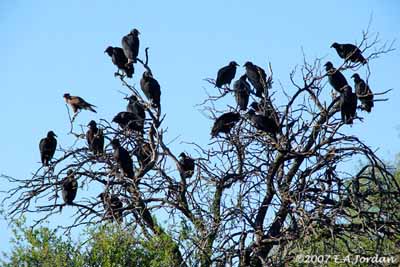
They nest on the ground, in caves, in large tree holes, stumps of fallen logs. The large condors nest in remote sites difficult to reach.
The birds try to make their movements as inconspicuous as possible when they approach their nest, in order to avoid the ground predators. In addition, the nests become rather foul-smelling, and that would be a strategy to prevent predators.
But predation at nest-site is not a major cause of breeding failure, even if their eggs are sometimes taken by Ravens, and these large raptors do not develop strong nest defence.
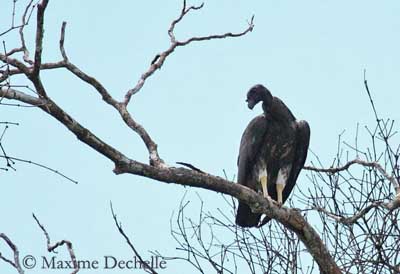
Immature
These raptors lay between one and two eggs, more or less marked according to the nest-site. Incubation periods are variable, from 40 days for the smaller species, to 55 days for the condors. Both parents seem to share the nesting duties such as incubation, and feeding of the young.
Chicks are covered in white down for most of them, and buff-brown in American Black Vulture. The thick covering of down allow the chicks to keep themselves warm from an early age. Parents feed them and visit the nest for a few minutes each day. Chicks are fed by regurgitation during the whole growth period.
It is unusual for birds of prey to carry the food in such way instead in the feet, but these vultures probably have larger crops and their talons are not very strong.
During the first days, the chicks are fed with partially digested food received from the adult’s bill, but later, the parents regurgitate directly on the ground.
In condors, the young does not fly before six months of age, and it remains dependent on parents for food for many months.
Cathartids seem to form permanent pair-bonds or at least, long lasting pairs.
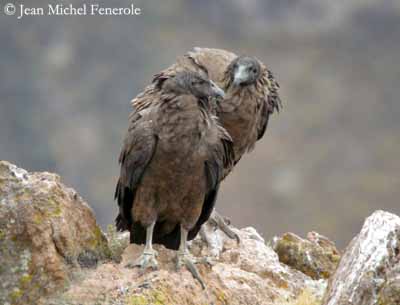
Juveniles
Cathartids are not really migratory birds, except the Turkey Vulture, and mainly some of its races. The two North American subspecies (aura and septentrionalis) travel southwards in winter in large flocks, to northern South America where they live with the resident races of the same species and are dominant due to the great numbers of migrants.
No other species of the family Cathartidae performs migrations, but local movements and dispersions are observed over short distances. But this behaviour is not yet understood.
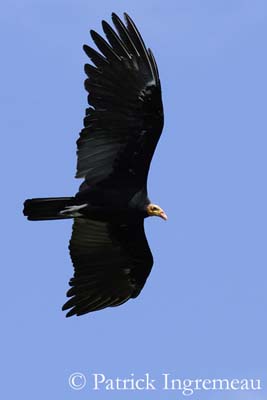
Like the Old World vultures, the American species were persecuted in the past because they were blamed for killing newborn lambs and for spreading diseases of livestock. In addition, their habit to feed on garbage dumps and then moving to towns was not appreciated by humans.
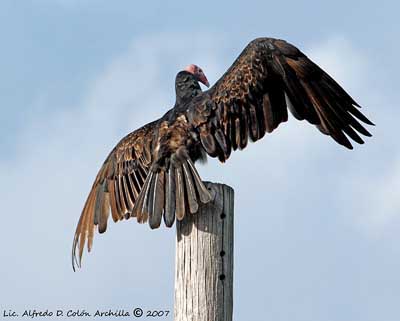
While feeding on roadkills, they often are killed by cars and they also eat poison present in some items found on rubbish tips.
Fortunately, the high reproductive rate of some species allows them to maintain stable populations.
The deforestation is the main threat for the forest species, and the human exploitation of the remaining wooded habitats involves a heavy hunting pressure.
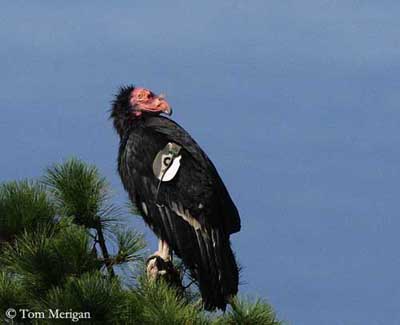
The most endangered species are the two condors. The California Condor populations are managed by several programs of breeding and reintroduction (see the card of this species), which also include the conservation of the Andean Condor also threatened.
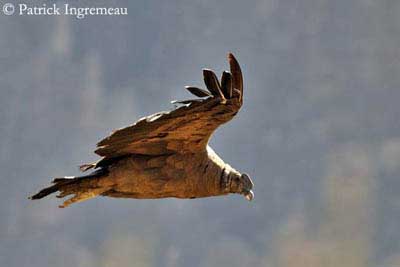
Immature
However, we can hope to see these superb large raptors flying for long time in the sky of the Americas, making true the famous original Peruvian song “El Condor pasa” where this handsome condor is the symbol of freedom by the way of its majestic flight over the landscapes of the Andean mountains.
